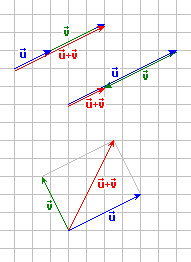|
ACTIVITY 2.8 |
|||
|
Sum of two or plus forces it is called resulting. In the next unit we will see what we must make to calculate the module of a vector sum. Nevertheless, there are two cases in which to obtain the module from the resulting of a sum is very easy: 1) When the forces have the same direction. Then: 2) When forces are perpendicular we can apply Pythagoras's theorem. If, as usual, we indicate the vector module |
 |
|
INTERACTIVE ACTIVITY A boat must move by a canal with the help of two forces 1) Without varying the force 2) You update this web page and repeats the exercise, now without varying the force 3) You update this web page again and repeats the exercise varying the two forces simultaneously |
|
| HOMEWORK |
You try to solve the problem numerically of interactive activity in the 1) and 2) cases and compare the results with its obtained previously.
Indication for case 1: You observe that![]() = (1.4, 2.65), calls components of
= (1.4, 2.65), calls components of![]() = (g 1, g 2) and you try to calculate
= (g 1, g 2) and you try to calculate![]() +
+![]()
and you try to calculate g 2 . Can you calculate g 1 with the knowledge that you have?
Indication for case 2: You observe that![]() = (1.91, -3.52), calls components of
= (1.91, -3.52), calls components of ![]() = (f 1, f 2), you make the sum of
= (f 1, f 2), you make the sum of![]() +
+![]()
and you try to calculate f 2 . Why is this result unacceptable?
|
END OF ACTIVITY 2.8 |
|||